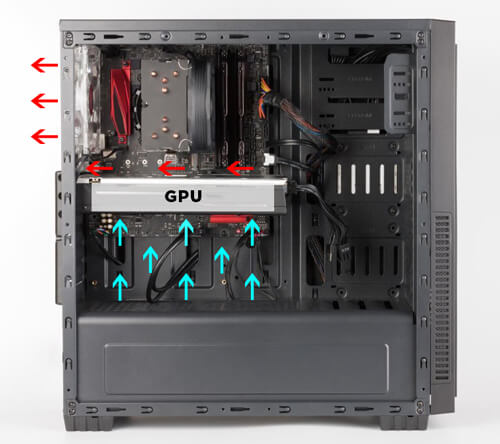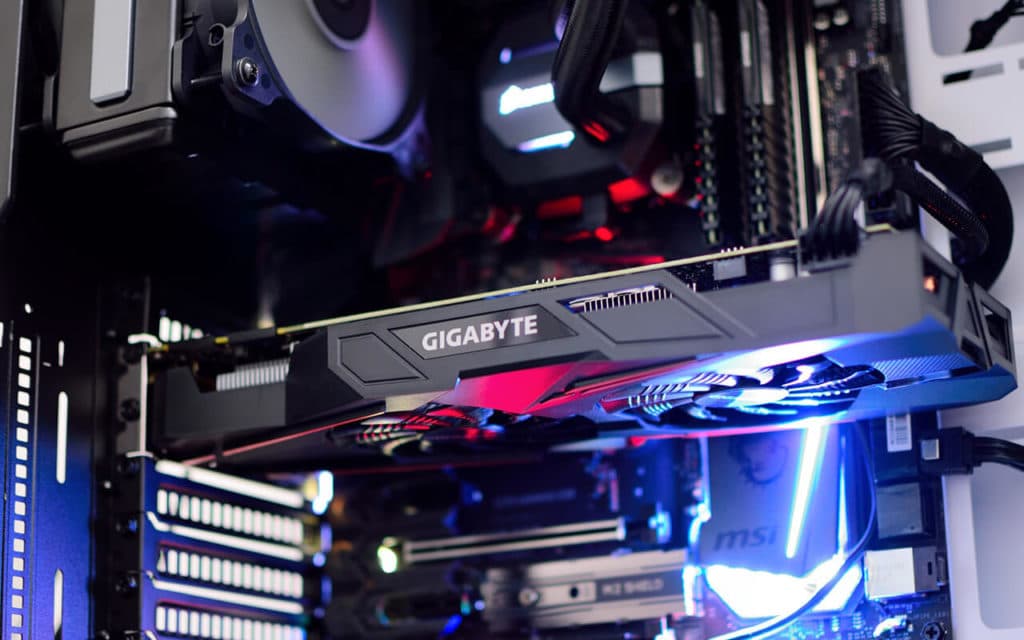It’s evident that one major aspect of gaming PCs is efficient cooling. That said, graphic card fans assist in keeping your GPU temperature cool.
As a computer expert, I’m quite familiar with nearly all gaming devices, but most importantly, I appreciate the role my GPU fans play when handling plenty of graphically intensive tasks.
The GPU fan of your graphics card is indeed a necessity for optimal PC performance. But are GPU fans intake or exhaust? In today’s write-up, we’ll discuss everything you need to know about GPU fans. Keep reading for more insight.
Table of Contents
Are GPU Fans Intake or Exhaust?
Most GPU fans act as intake. They draw in cold air from your PC into the GPU case. So technically exhaust fans blow air inward, into the heatsink/graphics card. That implies why weather and hot temperature inside the room affect the thermals of your GPU.
How you set up your intake fan determines the overall performance of your precious PC components. Be mindful that heating isn’t pretty cool for your graphic cards. Or simply ‘hot hardware is unhappy hardware.’

So the position you place your GPU fans in matters a lot. Having it configured and installed the right way ensures your graphics card stays cool by maintaining not only airflow but the breeze as well (maximum system cooling).
A simple rule of thumb is: fresh cool air in, hot air out of the system. So you should possess the knowledge of how to place intake fans properly.
Is Dual Fan GPU Better Than Single?
Does it matter if your gaming PC is using a single or dual-fan GPU? Not really. It depends on the amount of hot air your graphics card outputs, not the number of fans. For instance, two inferior fans can remove less heat from the GPU than one good fan. That means the entire cooling system might underperform with more fans.
But in theory, two fans are better. They don’t have to work hard to keep the card cool. Quality dual fans provide excellent cooling and efficiency while running at lower RPMs. They do operate quietly.

A single fan is just OK unless you live in very hot areas or during hot summer days. My single fan GTX 1650 has impressed me so far. It runs cool to ensure my graphics card doesn’t get too toasty when playing my favorite online game.
One fan is nowhere good enough for high-end GPUs but is fine for budget GPUs.
Single Fan vs. Dual Fan GPU – Know the Difference
GPU functionality is essential when it comes to your custom gaming rig. Both types of GPU feature excellent cooling systems, including a fan and a heatsink. The components are aimed at sucking out excess heat from the system while maintaining the best temps for your card.
The two types split significant differences in terms of cooling performance, noise levels, functionality, and overclocking ability just to mention a few.
Here are the differences between them:
| Features | Single Fan GPU | Dual Fan GPU |
|---|---|---|
Size | Small – Perfect for small PC cases | Works with most medium and high-end PC cases |
Overclocking performance | Fitted with a single fan, there’s a loss in efficiency for high overclocks | Dual fans help maintain excellent airflow and ventilation, hence excellent cooling efficiency |
Noise levels | Can be noisy, which is annoying while working or gaming | Operates quietly and barely produces noise |
Functionality | Functions via a blower-type cooling system | It uses an open-air refrigeration system to keep the components breezy |
Overall, dual outsmarts a single fan GPU in every category. If we consider the whole cooling solution, the dual fan GPU is worth backing, thanks to its additional fan.
Avid online gamers are looking for high-end GPUs with multiple fans to achieve solid performance. The latter is fairly good to fit into small cases
Should Graphics Card Fans Always Spin?
Actually, it depends. Modern graphics card fans won’t start up until a certain temperature is reached. One excruciating problem you can run into is the GPU fan not spinning at all or sporadically. This would cause a moment of panic for beginners.
In most cases, the fans run when you’re playing high GPU-intensive games since the temperature keeps rising. Fans should spin under high temps or heavy loads. If they don’t, then there’s a problem.
The normal GPU temperature while gaming is anywhere between 60°C and 85°C. The fans come in handy to keep your system cool, preserving the longevity of your components.
If one component runs hot in an enclosed case, your entire GPU won’t perform as expected.
Keep in mind that if you increase your GPU’s workload, the card heats up. Why would the GPU fans not spin?
Here are the fixes to get your GPU fans working well again:
Is Single Fan GPU Suitable For Gaming?
Yes, it’s good enough for gaming. But it depends on the kind of game you’re after.
Those playing graphic-intensive games won’t enjoy the best experience at room temperature.
You can however enjoy smooth gameplay if you choose games with mid-end graphics.
Should GPU Fans Face Up Or Down?

Downward. Hot air rises while cold air stays at the bottom of the case.
And since you want to pull cold air into the graphic card, the fan must face down.
The Bottom Line
You now know that GPU fans function as intake. The ‘intake fan(s)’ on your GPU help your PC system stay cool under high temperatures. And that’s how the GPU fans work.
For gamers, don’t let your GPU overheat because it’s the heart of your gaming experience. If the GPU fan doesn’t spin when a particular temp is reached, be sure to check it out.

Be the first to comment